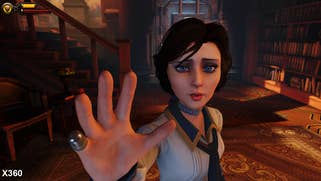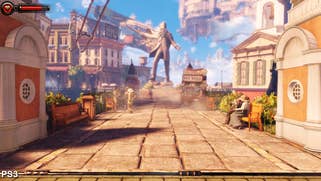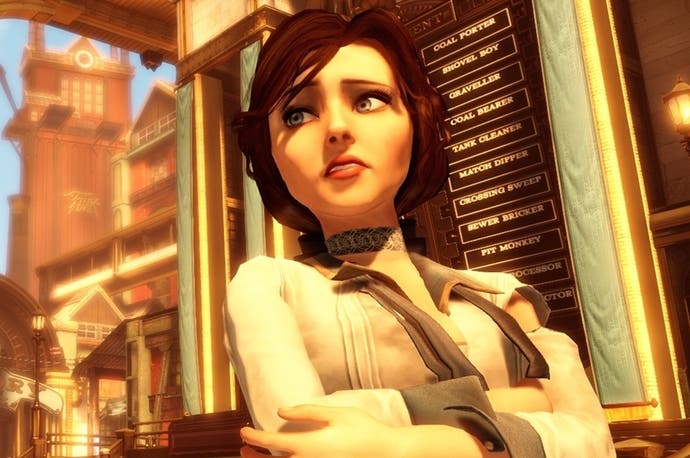Face-Off: BioShock Infinite
Rapturous.
| - | Xbox 360 | PlayStation 3 | PC |
|---|---|---|---|
| Disc Size | 6.6GB | 6.63GB | 14.9GB (download size) |
| Install | 6.6GB (optional) | - | 17.4GB |
| Surround Support | Dolby Digital | DTS, 5.1LPCM | Set-up Dependent |
Released to immense critical acclaim, BioShock Infinite is a masterclass in game design, combining fast-paced action with impressive AI characters, driven by an intriguing storyline that forms an utterly compelling experience far more ambitious in scope than its predecessors. From a graphical perspective, the game may fail to rival visual showcases like Crysis 3, but its core technology is a perfect match for the game's artistic style, while the environmental and AI design brings the floating city of Columbia and its characters to life in unforgettable fashion.
All of this is achieved through the use of a heavily modified version of the Unreal Engine 3 middleware. Changes here include the implementation of a deferred lighting set-up, adding dynamic illumination across the constantly moving buildings of Columbia, a customised animation system running over Natural Motion's Morpheme technology that brings more nuanced character movement to the screen, and a complete rewrite of the AI systems that govern the non-playable characters and enemies throughout the game - with a special focus on Elizabeth, an exceptional creation who accompanies the player throughout most of the adventure.
The technology is key to realising the BioShock experience, but how well does this translate across multiple platforms? Past BioShock titles were designed with Xbox 360 and PC in mind, with PS3 ports producing sub-optimal results. However, for this sequel Irrational Games has rewritten much of UE3, allowing graphics quality and performance to scale across multiple CPU and graphics cores, leveraging today's focus on parallel processing by dividing up workloads into smaller jobs that can be spread across multiple cores with ease. This is good news for PC and Xbox 360 of course, but in theory the approach should yield excellent results from the PS3's SPU set-up too.
Indeed, from a visual perspective the two console versions of BioShock Infinite appear very close indeed, with performance the defining factor rather than image quality. Our head-to-head videos below - along with a triple-format comparison gallery - reveal only subtle differences between the PS3 and 360 releases. Meanwhile the PC game is a whole different ballgame, benefitting from the vastly superior hardware of today's gaming computers to deliver high-quality effects and artwork to the screen that makes that version of the stand out considerably when playing in extremely high resolutions.
"The PC game is the definitive edition, packed with visual improvements over both the Xbox 360 and PS3 versions."
Alternative comparisons:
Beyond the impressive construction of a dynamic floating city, the carefully stylised early 20th century American architecture lies beneath a veil of softness that primarily affects the game on both consoles, also affecting the PC version when played in lower resolutions. It's disappointing to discover that fine details are often smoothed over by a distinct blur that does little to hide the appearance of jaggies across objects and structures featuring lots of sub-pixel geometry, thus reducing the impact of a city designed to look clean and colourful.
Despite the soft look, BioShock Infinite renders natively at 720p on both 360 and the PS3 with the distinct blur caused by the inclusion of a heavy post-process anti-aliasing solution that smoothes over pixel-wide edges along with texture details. It's difficult to say for sure, but our guess is that we're looking at differing implementations of FXAA in play across each format. Despite producing varying results at a pixel level, the effect of the edge-smoothing is almost identical in motion on both consoles, with the level of sharpness changing on a scene-by-scene basis depending on a range of factors, from the amount of additional post-process effects in play to the lighting conditions. [Update: after spending more time with the game and taking another look at the assets, we now reckon that Xbox 360 renders at 1152x720 with PS3 coming in at 1152x640.]
In comparison, the FXAA implementation is a touch more refined on PC. Overall image blur is reduced in many scenes and this allows the artwork to better cut through the slight softness caused by the anti-aliasing solution. In some cases we find image quality isn't far removed from the consoles, but with one key difference: the use of higher-resolution artwork allows for finer details to manifest. This is far more apparent the higher up the resolution chain you go, with softness becoming a complete non-issue when running the game in 1080p. The extra pixel precision on offer leads to edges being smoothed over without impacting much on the surrounding artwork, even allowing lower-quality textures to be displayed without having them appear quite as murky as they do on the console versions. This is especially noticeable when comparing the 360 version upscaled to 1080p against the PC version running natively at the same resolution.
"BioShock Infinite is beautifully built to scale up to higher resolutions on PC, where the art and effects truly shine."
The level of detail is further amplified on the PC through higher-quality normal maps and greater geometry complexity in parts of the environment. Statues feature more angular curves that project better defined shadows across the surrounding surfaces, while small bumps and cracks are given an extra layer of three-dimensionality over the same surfaces found on consoles. On the other hand, there's little to separate the PS3 and 360 releases from each other: textures and normal maps are a close match, although we find the level of filtering to be a little higher on the PS3, adding a touch more clarity in some places. Shadows are rendered in slightly higher resolution on the 360, while an off-set bias causes some lights and shadows to appear in different places on PS3, with elements such as specular sheen and lighting bloom dialled back slightly as a consequence.
Parity also extends to the quality of the effects work, with low-resolution reflections utilised on both consoles, along with alpha buffers for some transparent objects. This is in stark contrast to the PC game where a range of higher-precision and higher-resolution effects enhance the appearance of depth of field, SSAO, reflections, transparencies and lighting.
All of this helps to add yet more clarity to the striking architecture of Columbia, although there are a few hiccups along the way. Streaming has never been a strong point of UE3, and while many of the issues found in earlier games that use the engine have been taken care of we still find the occasional bug where low-quality art will pop back in after high-resolution assets have been loaded up, or where certain objects simply fail to appear at all. All three versions are affected to some degree, although during our time with the game these issues came up slightly more frequently on the 360 and PC. Character shadows are also strangely pixellated on the PC version in comparison to the consoles, with these artifacts clearly standing out when characters are close to the camera. We have to wonder whether this is a driver bug. [Update: This is now confirmed as a driver issue that has since been resolved.]















Despite these minor rendering issues, the core experience is well preserved on all platforms when it comes down to the world Irrational Games has created. In particular the realisation of Elizabeth as a fully formed autonomous character is nothing short of outstanding. Advanced animation systems in combination with some clever AI and scripting help to bring her to life in a way we've not seen before in other games. It's hard not to think about her as anything but a valued companion interacting with you throughout the game, rather than as a focused NPC that simply drives the story forward.
Likewise the technological innovations employed in bringing to life the airborne city of Columbia are remarkable. The use of a deferred lighting set-up sees a multitude of real-time lights illuminate the city in a natural way. Scripted day/night transitions running in real time completely change the look and feel of key locations, and the inclusion of a custom per-pixel dynamic relighting scheme allows for characters and dynamic objects to receive the benefits of global illumination, thus making these elements sit better within the scene.
While this is quite impressive, the streets of Columbia are sparsely populated for a world at the height of its power. Civilian NPCs freely roam around certain sections of the city designed to set the tone for parts of Columbia, but when the shooting starts they are nowhere to be found, leaving the streets feeling rather deserted. It's disappointing to see a world designed around feeling very alive, actually having very little life in it. More than anything this appears to a consequence of the advanced AI routines being used by Elizabeth and the enemies situated throughout the city - we can well believe that limitations in processing power restrict how many characters it is possible to have on-screen at once.












BioShock Infinite: performance analysis
The attention to detail lavished on BioShock Infinite as a whole is obviously impressive, but how well does this translate to performance? Typically, titles using UE3 are relatively easy to run on PCs, where fairly modest specifications yield high frame-rates, while console performance is more variable. However, the revised technology powering the game has seen some significant modifications that make BioShock Infinite more demanding that many titles that utilise the stock UE3 middleware.
On our mid-range gaming rig powered by an Intel Core i5 processor and Radeon HD 7870 graphics card, we had little problems running the game at max settings in 720p while maintaining a consistently solid 60FPS, providing us with much smoother gameplay than found in the 360 and PS3 versions of the game. Frame-rates are occasionally impacted during situations where the screen becomes filled with elements and pyrotechnics, but the end result is a mostly solid 60FPS experience. Achieving the same level of performance at 1080p is more difficult without making some graphical tweaks in order to reduce the overall rendering load. Some settings - such as the alternate depth-of-field and higher-quality screen-space ambient occlusion (SSAO) modes - had to be reduced to more closely hit the desired frame-rate. Disabling v-sync also helps increase raw frame-rate, but the unsightly tearing is something we'd rather not put up with on a PC utilising a £160 graphics card.
As you'd expect, console performance is less impressive overall, with the significantly older hardware often struggling to maintain a stable update when the engine is under stress. Frame rates are generally higher on the PS3 across a basic run of play factoring in various scenarios, but particularly when under load, where the added smoothness translates into more responsive controls during intense fire fights where quick reactions count. Unfortunately, this comes at the expense of some hefty screen-tearing. UE3-standard adaptive v-sync is used on the PS3, where the engine locks at 30FPS, tearing when frame-rate dips beneath the target. For its part, the 360 the game is more solidly v-synced: tearing occurs at the top of the screen but we see the level of smoothness drop more sharply as the GPU stalls while waiting for a new frame to be completed in time for the next display refresh.
"Irrational aims for a locked v-sync on Xbox 360. PS3 is clearly smoother as a result, albeit with noticeable levels of screen-tear."
The bottom line is that the 360 game enjoys a higher level of visual integrity, but in comparison to the PlayStation 3 version it takes a hit in terms of smoothness and response. This is most apparent in areas of the game that feature open parts of the enviroment with long draw distances and also during alpha-heavy scenes where explosions and other similar effect are used. In less demanding scenes featuring fewer enemies and effects there is little to separate the two at all: a constant 30FPS is regularly maintained in reasonably intense battles located in more enclosed indoor areas of the game. Likewise, heavily scripted sequences featuring destructible environments don't appear to cause any issues, as long as draw distances are kept short and there isn't an abundance of particle effects or multiple light sources in play. Overall, it's clear that both approaches have their strengths and weaknesses. Those more susceptible to screen-tearing may well prefer the more consistent look of the 360 game, although, in our estimation, the smoother frame-rates on PS3 mean that it feels slightly better to play.
Curiously though, there is another option. Just like previous BioShock titles, it is possible to disable v-sync and run with an unlocked frame-rate on both consoles in order to enjoy higher frame-rates, but this does come with some unwanted side effects. For one, near constant screen-tearing is present on both versions, causing an unsightly judder effect, especially evident during fast camera pans. On the flipside, frame-rates are indeed higher on both platforms, with the PS3 gaining noticeable advantage across a general run of play, although alpha-heavy scenes still tend to favour the 360. We can't help but wish that Irrational had gifted Xbox 360 with the same "lock at 30, tear beneath" option that comes as standard on PS3. It would have been fair more preferable to the simple v-sync on/off option.
BioShock Infinite: the Digital Foundry verdict
"What we love most about BioShock Infinite is the way in which technology and game design come together to deliver a unique experience."
Despite our concerns with performance on console, Irrational Games still manages to deliver an engrossing experience across all formats, where the core experience is so strong that the game is an essential purchase no matter which platform you own. The extra clarity afforded by the PC version better represents the stylised artwork on offer, while smoother frame-rates certainly make the combat sequences so much more enjoyable to play, with more responsive controls delivering an extra dimension of precision needed in fast-paced shoot-outs. If you have the hardware capable of running the game smoothly, the PC version is the game to buy.
However, the console releases are still outstanding releases that come highly recommended. The shooting isn't as much fun when frame-rates are crashing down but most of the other elements that help make BioShock Infinite such an accomplished release are fully in effect. The more responsive PS3 game gets the nod for delivering a more consistent, flowing gameplay experience and its deficit in terms of rendering resolution is really difficult to pick up on bearing in mind how strong the FXAA blur is on both platforms. The addition of tearing isn't particularly attractive, but the extra controller response is preferable during intense combat scenes. Alternatively, those especially susceptible to screen-tear may prefer the 360 version, despite it featuring heavier dips in performance in more demanding scenes.
Overall, BioShock Infinite is certainly one of the most entertaining games we've played in a long, long while. At its core, the power/weapon-based combat is similar to previous games in the series, but what sets this sequel apart is how all the different elements come together coherently to form a compelling, irresistible experience, where Elizabeth takes centre stage. Impressive AI and animation are combined with excellent dialogue and delivery that help to give her real character throughout the whole adventure, even if some of the gameplay mechanics surrounding her are a little underused. What we love most about BioShock Infinite is the way in which technology and game design come together to deliver a unique experience. With this philosophy in mind, we're excited by the possibilities next-gen platforms represent to a developer like Irrational. Let's hope we don't need to wait another five years to see its next game...


















